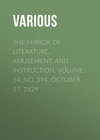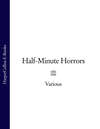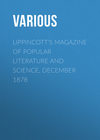Read the book: «The Mirror of Literature, Amusement, and Instruction. Volume 14, No. 394, October 17, 1829», page 5
THE TRUE FORNARINA
The account of a journey which was taken in the year 1664, by Cosmo, the son of Ferdinand II. de Medici, was written at the time, by Philip Pizzichi, his travelling chaplain. This work was published for the first time at Florence, about seven months ago. It contains some curious notices of persons and things, and among them, what will interest every lover of the fine arts. It is this—speaking of Verona, he mentions the Curtoni gallery of paintings, and says, "The picture most worthy of attention is the lady of Raffaello, so carefully finished by himself, and so well preserved that it surpasses every other." The editor of these travels has satisfactorily shown that Raffaelo's lady here described is the true Fornarina; so that of the three likenesses of her said to be executed by this eminent artist, the genuine one is the Veronese, belonging to the Curtoni gallery, now in the possession of a lady Cavellini Brenzoni, who obtained it by inheritance.—Monthly Magazine.
ITALIAN SCENERY
Happy is the man, who, leaving the Alps behind him, has the plains of Lombardy on his right hand and on his left, the Apennines in view, and Florence as the city towards which he directs his steps. His way is through a country where corn grows under groves of fruit trees, whose tops are woven into green arcades by thickly-clustering garlands of vines; the dark masses of foliage and verdure which every where appear, melt insensibly, as he advances, into a succession of shady bowers that invite him to their depths; the scenery is monotonous, and yet ever various from the richness of its sylvan beauty, possessing all the softness of forest glades without their gloom. Towards Bologna, the landscape roughens into hills, which grow into Apennines, but Arcadia still breathes from slopes and lawns of tender green, which take their rise in the low stream-watered valleys, and extend up the steep ascent till met midway by the lofty chestnut groves which pale them in. To these gentler features succeeds the passage of the Apennines, which here, at least, are not as the author of "Italy as it Is," describes them, "the children of the Alps—smiling and gentle and happy as children should be," but, as we remember them, their summits form themselves into a wild, dreary region, sown with sterile mountain-tops, and torn to pieces by wind and storm; the only glimpse of peace is derived from the view on either side of the sea, which sometimes shows itself on the horizon, a misty line, half silver, half ether. This barren wilderness again softens into gracefully-swelling hills turned towards Florence. The fair olive tree and the dark cypress mingle their foliage with the luxuriant chestnut boughs, and the frequent marble villa flashes a white gleam from amid its surrounding laurel bowers. The sky is more beautiful than earth, and each symbolize peace and serene enjoyment.—Westminster Review.
MUSICAL MARVEL
One of the most amusing stories in ancient history, of the successful and happy use of fine music, is told of Arion, who, when about to be thrown overboard by some mutinous sailors, begged leave to sing to his lute one funeral strain before his death. Having obtained leave, he stood upon the prow with his instrument, chanted with a loud voice his sweetest elegy, and then threw himself into the sea. A dolphin, as the story goes, charmed with his music, swam to him while floating on the waves, bore him on his back, and carried him safely to Cape Taenarus, in Sparta, from whence he went to Corinth. It would have been well for the mutineers if their taste for music had been as great as the dolphin's, for the history not only affords a grand instance of the power of music, but of retributive justice, as the sailors accidentally going to Corinth, paid the penalty of their evil intentions with their lives.
POPULATION OF AUSTRALIA
Mr. Martin mentions a very curious fact. The increase of population, he says, has been most rapid, and is to be accounted for by the number of females born, the proportion being, with regard to males, as three to one! The great preponderating number of females brought forth among domesticated animals, will account for the countless herds of cattle which overspread the colony.—New Monthly Magazine.
SPIRIT OF THE PUBLIC JOURNALS
THE BLACK LADY OF ALTENÖTTING
With the exception of the shrine of the Three Kings at Cologne, there exists throughout Germany no spot of greater sanctity, no altar of richer endowments, than the Chapel of the Black Lady, on the frontier of Bavaria. The hearts of its sovereign electors have been deposited, from century to century, within the consecrated cells; nor is there an historic event, involving the interests of their own, or the adjacent kingdoms, which is not supposed to have been influenced by her potent interposition. A sufficient history, in fact, of the destinies of the whole empire, might be recorded in a mere catalogue of the national offerings to the shrine of Altenötting.
In rambling through the eastern provinces of Bavaria, some few springs ago, I chanced to arrive one glowing afternoon at the post-house of an inconsiderable town; which, from the grass-grown tranquillity of its streets, and from a peculiar air of self-oblivion, appeared to be basking fast asleep in the sunshine. There was little to admire in the common-place character of its site, or the narrow meanness of its distribution; yet there was something peculiar in its look of dreamy non-identity; and had it not been for the smiling faces of the fair-haired Bavarian girls, who were to be seen glancing here and there, with their embroidered purple bodices and coifs, and silver-chained stomachers, I could believe myself to have reached some enchanted realm of forgetfulness.
As I entered the Platz, or market-square, of the little town, chiefly with a view to the nearer inspection of the cunning workmanship of the aforesaid carcanets of silver, a light sprinkling of April rain began to moisten the pavement—one of those unheard, unseen, revivifying showers, which weep the earth into freshness, and the buds into maturity. I was anxious, however, to withdraw my mere human nature from participation in these herbaceous advantages; and looking about for some shelter which might preserve me from the mischiefs of the shower, without depriving me of its refreshing fragrance, I espied in the centre of the Platz—a square of no mighty area—a low, rotunda-like building, with slated roof, overhanging and resting upon wooden pillars, so as to form a sort of covered walk.
I settled with myself that this was the market-house of the town, and hastened to besiege so desirable a city of refuge. But during my rapid approach, I observed that the external walls of the nameless edifice beneath the arcade were covered, and without a single interstitial interval, by small pictures in oil-colours, equal in size, and equal in demerit, and each and all representing some calamitous crisis of human existence—a fire, a ship-wreck, a boat-wreck, a battle, a leprosy! It occurred to me at the same moment, that this gallery of mortal casualties and afflictions must be a collection of votive offerings, and that the seeming market-house was, probably, a shrine of especial sanctity. And so it was!—the shrine of "The Black Lady of Altenötting."
Instigated by somewhat more than a traveller's vague curiosity, I entered the chapel; the brilliancy of which, eternally illuminated by the reflection of a profusion of silver lamps upon the thousand precious objects which decorate the walls, forms a startling contrast with the dim shadows of the external arcade. In most cases, the entrance to a religious edifice impresses the mind with a consciousness of vastness, and a sensation of awe:—
"–the tombs
And monumental caves of death look cold,
And strike an aching dullness to the breast."
But the chapel of the Black Virgin is diminutive as a boudoir, and yet retains the usual character of listening and awful stillness, the ordinary impression of local sanctity. A few peasants were seen kneeling in utter immobility and self-abstraction beneath a lamp, which seemed to issue in a crimson flame from a colossal two-fold silver heart, suspended from the ceiling—their untutored minds were elevated into the belief of a heavenly commune.
In a glass case above the altar, is deposited this far-famed effigy of the Holy Galilean virgin—a hideous female negro, carved in wood, and holding an infant Jesus in her arms of the same hue and material; and exhibited in its extremity of ugliness by the reflected glare of the silver and diamonds, and gems of every description, by which she is surrounded. Chests, mimic altars, models of ships, crowns and sceptres, chalices and crosses of gold and silver and enamel, and enriched with
Turkish blue and emerald green,
and every jewel of every land, lie amassed in gorgeous profusion in the adjoining cases, and seemed to realize the fabled treasures of the preadamite Sultans. Boasting themselves as gifts of gratitude or invocation from emperors and popes, kings, princes, palsgraves, and all the other minor thrones and dominions of the earth, these splendid offerings form the most plausible illustration of the miraculous power attributed to the image of the Black Lady, which has been deposited in its actual abode since the year of Grace 696. In the course of the Thirty Years' War, this important relic and its treasury were twice removed into the city of Salzburg, for security from the Swedish invaders; and twice brought back in solemn triumph to their ancient sanctuary.
But a mightier charm than that of gems or metals, the most precious or the most beautiful, connects itself with the chapel of Altenötting—its association with historical names of all ages, from Charlemagne and Otto of Wittelsbach, whose monuments we find inscribed in Runic characters, to Pius the Sixth, whose dedication, "O clemens, O pia Virgo Oettingana!" is graven in a "fine Roman hand." It contains sepulchral vaults of the families of Wallenstein, Tilly, Montecuculi, besides those of divers electors, archbishops, and archdukes, whose titles speak far less stirringly to the heart; altogether forming an illustration of the past, which brings the dark ages in living majesty before our eyes.
Alternately dazzled and disgusted by this fruitless waste of splendour, this still more fruitless waste of national credulity, I was pondering over the domestic virtues of a certain "Franziska Barbara, Countess of Tilly," as recorded over her grave, when the chants of the priests, who had been engaged in the celebration of mass before the altar, suddenly ceased; and, as the last fumes of the incense circled upwards to the blackened roof, there arose another and a solitary voice, evidently of lay intonation, and deepened by that persuasive earnestness of devotion which, like an electric chain, connects in holy feeling all sects of the Christian church. It spoke in the fulness of gratitude, and in the humbleness of prayer; and although the dialect was tinged with village barbarism, and its thankfulness addressed to the Black Virgin, I heard in its simple solemnity only the beauty of holiness; and, overlooking the visible shrine, beheld in its ultimate object the tribunal of divine mercy!
The devout speaker was one of a peasant family who had entered the chapel unobserved, during my contemplation of its glittering decorations. He was apparently a Bavarian farmer, somewhat advanced in years, and wearing, in addition to his richly-substantial holiday attire, a deep green shade over his eyes, which accounted for the character of his thanksgivings to the miraculous image. "I thank thee, O most benign and saintly Maria!" had been the tenour of his prayer, "for the scattered and glorious gifts of Heaven, which had become as vain things to my soul, till thy grace renewed them in its knowledge. I thank thee for the summer skies and the green pastures—for the footsteps which no longer crave a helping hand—for the restored faces of my beloved ones—and, above all, O holiest Virgin! I glorify thy name in gratitude for the precious means by which the blessing of sight hath been again vouchsafed me!"
This last mode of expression excited my curiosity, and when the little group of votaries had concluded their ceremonies, had affixed their consecrated tapers at the shrine, and deposited their oblations with its officiating priests, I followed their joyful footsteps out of the chapel, and was again struck by the delicious transition from the heated and incense-laden atmosphere of its interior, to the pure, balmy April air without, gushing with the sweetness of the passing shower.




















